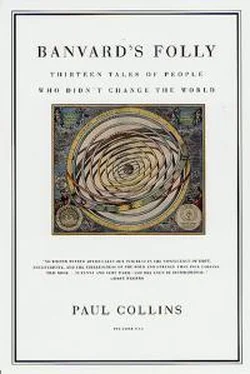Scientific American, with a sigh, explained yet again in its June 23 issue that blue sunglasses did not focus the rays of the sun upon the eye--to contrary, they merely shaded it somewhat.
In addition to beratements by The Manufacturer and Builder, which as early as 1871 had labeled Pleasonton's work "absurd," Scientific American's attacks were followed by a series of publications by Thomas Gaffield, collected in a booklet entitled The Blue-Glass Mania (1877). Gaffield had spent years collecting scores of glass panes from around the world and arranging them on the roof of his house in Boston, all in order to observe how different types of glass aged under the sun. He'd already spent fourteen years doing this, and so he understandably considered himself something of glass expert. His Mania articles effectively blew apart any scientific foundation that Pleasonton might have thought he was standing on. He was particularly hard on Pleasonton's lack of control groups in his experiments and on his numerous self-contradictions: his claims, for example, that blue light killed houseflies, but also made silkworms grow more quickly. But when the end did come it was not so much due to hard work of critics like Gaffield as to the simple life and death cycle of any fad.
By 1878, blue glass was over.
Like any good medical fad, blue glass persisted on in various forms and guises for many years afterward, and never with even a nod to its originator.
In the 1890's, John H. Kellogg started a run on "light baths"-enclosed wooden sitting boxes lined floor to ceiling with electric lightbulbs--and so a new generation of desperate consumers was primed for the return of the notion that colored light might be useful too.
Professor Niels Finsen continued earnest and rather more careful experimentation with colored light at the turn of the century, with results that occasionally seemed to indicate that blue light could stimulate movement in tadpoles. It was fairly inconclusive, though, and he was soon irritated at how charlatans abused his tests--"My name has been used in a way which could not fail to meet with my disapproval," he griped in his book Phototherapy (1901). But under his guidance, doctors were soon dragging powerful marine searchlights into their offices, covering them with enormous blue lenses, and then standing patients in front of them. After a few years with little to show for this, the idea faded away.
The most larcenous of the lot was Dinshah P. Ghadali, founder of the
"Spectro-Chromo Institute," who claimed in his promotional materials to have been such a prodigy back in India that he was teaching college mathematics at the age of eleven. His career in the United States, though, seems based largely on the teachings of Rufus T. Firefly. After stints as a "medical electrician," an insurance agent, and founder of the "Anti-Forgery Electric Pen Company," he discovered the panacea of colored light. His intensive courses in "Spectro-Chromo Therapy"--just $100 cash in advance, if you please--taught the "restoration of the human Radio-Active and Radio-Emanative Equilibrium by Attuned Color Waves." It was a medical advance so truly marvelous that in 1925 the federal government rewarded him with a generous term in an Atlanta penitentiary.
The strangest variant of chromotherapy, though, came from Roland Hunt of "the Bureau of Cosmotherapy," with his 1940 book The Seven Keys to Colour Healing.
The book is a mixture of chromotherapy, Eastern religion, Christian mysticism, and some fairly wretched poetry:
In Coolness new, as refreshing dew; Tone Thou my Speech, O Rays of Blue-And make It True, And make it True.
Hunt's work is directly descended from Edwin Babbitt's earlier Principles of Light and Colour, but it goes farther than most in its claims. Blue-tinted water ("Ceruleo"), it turns out, also cures dysentery, cholera, and bubonic plague. "The importance of Blue as a saviour of life cannot be over-estimated," Hunt explains with great seriousness. "In Bombay thousands of lives have been saved from succumbing to Bubonic Plague, by administration of Ceruleo."
Augustus Pleasonton himself died in March 1894, and so he saw few of these travesties of his well-meaning work. He never did give up his belief in blue glass, nor his researches and constant scientific readings; when his estate was auctioned off in Philadelphia, his personal library had grown so large that it needed its own published auction catalog.
Pleasonton is not an easy man to track down today. There are numerous references in Civil War records to General A. J. Pleasonton ... except that these are for his gallant younger brother, Albert Pleasonton, who was also a Union brigadier general, but with the Army of the Potomac. Even in his own lifetime, Augustus was always confused with his little brother Albert. Search for Augustus Pleasonton, now, and you will find nothing. After all, he only served on the home front. He did not lead any charges, storm any hilltops, or see action at Antietam.
All he did was try to cure the human race of its mortality.
And to some extent, he succeeded. Writing in The North American Review in 1893, Dr. Cyrus Edson of the New York Health Deparment admitted that "some of the devotees not only declared themselves benefited by the treatment so long as they believed in it, but were unquestionably so benefited." But temporary placebos do not make for undying medical fame, and Pleasonton's 1894 obituary in The Times of London only briefly mused on "a craze which for some years held a vast number of people, including many on this side of the Atlantic. ...
Invalids of all classes would sit for hours in the blue light from a window pane waiting for a cure."
Not a word has been written on Pleasonton since. Perhaps the last published comment at all on blue glass came three decades later from Henry Collins Brown in his Valentine's Manual of Old New York (1926):
[There used to be] the almost universal belief in the efficacy of blue glass for whatever ailed you. Exactly how this craze began I do not now recall but I do remember that its virtues as a cure-all were on every tongue. The idea spread from a single pane, inserted in the usual window light, till the whole window was blue. ... The patent medicine men were in a panic. The nostrums which they sold were already guaranteed to cure everything but suicide and a broken neck; but the blue glass crowd went the limit in cures, and made no exceptions whatever.
For years, however, reminders of this strange manifestation remained in the shape of odd looking additions to houses; a lingering pane of blue glass here and there but that was all. ... The Blue Glass Parlor was undoubtedly the precursor of the light and airy Sun Parlor as we know it today.
The name of Pleasonton had slipped away entirely by now--all that remained were a few enigmatic blue panes. And although all sorts of "heliotherapies"
and ultraviolet treatments were pioneered in the early twentieth century to treat rickets, jaundice, and various skin ailments, the use of visible colored light faded from medical practice. In the end, Pleasonton's invention lapsed into eternal obscurity for the same reason that most other experimental
medical treatments do.
It didn't work.
YOUR GLORIOUS DAY IS COMING
Our wild Whitman, with real inspiration but choked by Titanic abdomen, and Delia Bacon, with genius, but mad ... are the sole producers that America has yielded in ten years. --Ralph Waldo Emerson,
We do not truly know our own times; at least, we don't know them as our descendants will. A literature scholar reading the above statement today would do a quick spit-take--no producers? 1857 ended what is now grandly called the American Renaissance--a period in the mid-1850's that saw the publication of Moby-Dick, The Scarlet Letter, Leaves of Grass, and Walden, and Emily Dickinson's first tentative publications of her poetry. And yet the best Emerson can do is half-heartedly endorse the young Whitman and ...
Читать дальше











